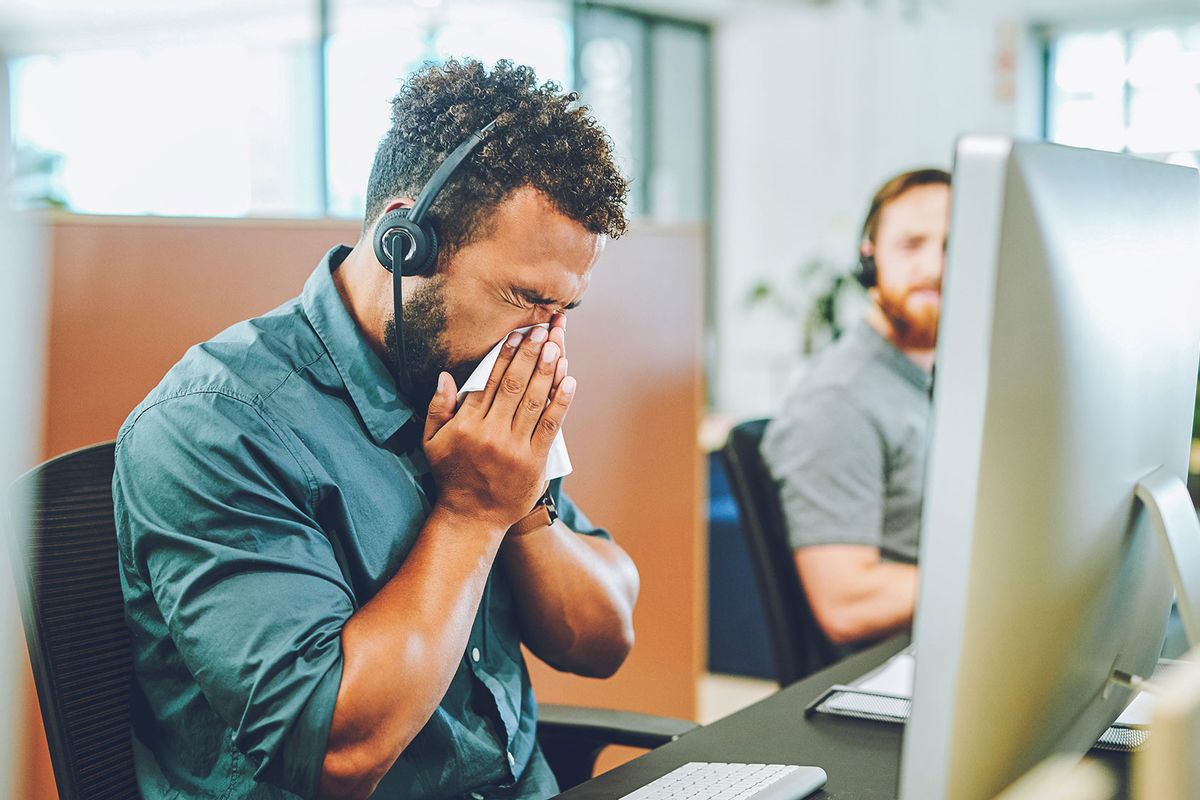Ill-gotten gains: Why does American society coerce us to we work while sick?

The Centers for Disease Control and Prevention (CDC) may soon remove its five-day isolation guidance for people who are infected with COVID-19, according to a recent report in The Washington Post. The alleged change has been attributed to several unnamed CDC officials. At the moment, the CDC hasn’t officially confirmed the report and instead has said that there are “no updates to COVID guidelines to announce at this time.” Still, the news follows similar guidelines enacted in California and Oregon last month, all of which has led to a major upset among many who are expressing feelings of defeat and disappointment.
Currently, when someone tests positive for COVID-19, the CDC recommends staying home for at least five days to reduce the chances of spreading the virus to others. However, sources told the Post that the change will rely on symptoms instead. If a person doesn’t have a fever or their symptoms are mild and resolving, they can still return to work or school if it’s within a day of testing positive. This change could come as soon as April, according to the report.
Notably, the science on how COVID-19 spreads hasn’t changed, which occurs via airborne particles and droplets. As to how long an infected person remains contagious is nuanced, and depends on how severe the infection is and the variant that caused their infection likely plays a role in all this as well.
One study found that some people could still carry the virus up to 37 days into their infection. The CDC even states that people with severe COVID-19 might be infectious after 10 days and might have to extend isolation for up to 20 days. What’s with the possible change then? Speculation is that it could reflect the reality that many Americans weren’t isolating themselves for five days anyway. But as one epidemiologist told NPR: “It’s like saying, well, people aren’t really wearing a seat belt, so I guess we can say seat belts don’t matter.”
A reversal in guidance like this will certainly “force people to work while sick.”
This change in guidance — if it occurs — seems reflective of one of the most toxic parts of American work culture — one that health advocates say is deeply harmful, impossible to shake and positioned to put lives at risk. It is, of course, America’s problematic “work-while-you’re-sick” culture, also known as presenteeism. Leanne DeRigne, a professor at Florida Atlantic University whose research focuses on labor participation and healthcare policies, told me in a phone interview a reversal in guidance like this will certainly “force people to work while sick.”
“If you have no protections to either guide you to stay home, and you have no way to recoup lost wages if you are sick, then I think this increases presenteeism,” DeRigne said. “More people will be working while they’re sick.”
Before the pandemic, Robert Half published results from a survey showing that nine out of 10 employees go to work sick. According to the survey, more than half of those who go to work sick said they go when they have a flu or cold because they have too much work on their plate. Another 40 percent, in the survey, said they go to work while ill because they don’t want to use up their sick time.
Want more health and science stories in your inbox? Subscribe to Salon’s weekly newsletter Lab Notes.
However, once the coronavirus began to spread, many wondered if presenteeism would wane as the public grew more fearful of those with a cough or sniffle — but that didn’t seem to last long. In one survey from the end of 2020 in Tennessee, 53 percent of participants admitted to going to work with COVID-19. And now, the continuous rollbacks in surveillance and policies to stop the spread of COVID-19 continue to put workers in vulnerable positions.
Currently, there is no federal sick leave program to protect workers who are infected with COVID-19. While some states have taken on various iterations of a COVID sick leave, not all workers have the option. As more middle-class workers do their jobs remotely — creating a culture of working from home while you’re sick — it leaves hourly paid workers who have to be physically at work without any safety nets. It’s this problem, DeRigne said, that perpetuates presenteeism.
“This really becomes a class issue and it’s concerning,” DeRigne said. “If it came coupled with a commitment to a federal guarantee of paid sick leave, that might be okay.”
“This really becomes a class issue and it’s concerning.”
She added that this work-while-you’re-sick culture is deeply rooted in the American psyche. As some have pointed out, the Protestant work ethic is still very much alive today. It carries an attitude that places immense value on the idea that hard work, discipline, and frugality are a result of a person’s values.
“I think we’re all committed to this idea that one of the ways we judge whether we’re worthy is whether we’re busy, whether we’re hard at work, and I think that just extends over into illness,” DeRigne said. “There’s something really embedded in our American psyche that being sick is seen as being weak and choosing to take care of yourself is the wrong priority.”
But it’s logically bad for business and the economy to have a bunch of sick people working, infecting one another and making more people sick. In fact, a recent systematic review published in the American Journal of Industrial Medicine last year found that paid leave was associated with numerous positive consequences for businesses — like increased job satisfaction, increased job commitment, increased firm performance, and improved retention.
DeRigne, one of the coauthors of the study, emphasized that such a change in policy will be “especially scary” for those who are vulnerable — like those who are immunocompromised or those who have long COVID, in which the symptoms of COVID-19 last for months or even years. Not every infection from SARS-CoV-2, the virus responsible for the disease, is benign or short-lived.
Angela Meriquez Vázquez, former president of the advocacy group Body Politic and a long COVID patient and advocate, agreed.
“The CDC is creating an insurmountable policy barrier for low-income and working class communities of color to both recover adequately from an infection and also prevent exposing their colleagues and the community members they interact with in service of bottom-lines and corporate profits.” Vázquez told me in an email. “The near-elimination of isolation protocols for infectious individuals compounds the health and well-being harms to people with Long COVID, especially those who are from low-income or communities of color.”
She added this potential change is “a clear example of how corporate interests are driving public health policy.”
As to how to unravel this systemic issue, DeRigne said nothing is ever going to change until there is a guaranteed federally paid sick leave in America — and to be effective, it has to be longer than five days.
“You’re really only moving the needle on job issues when you are giving them access to 10 or more days of sick leave or paid time off,” she said. “But if everybody had it, and we all started using it, would we get some better understanding that it’s just a normal part of life that some people are gone occasionally because they have to take care of themselves?”
Read more
about COVID-19



